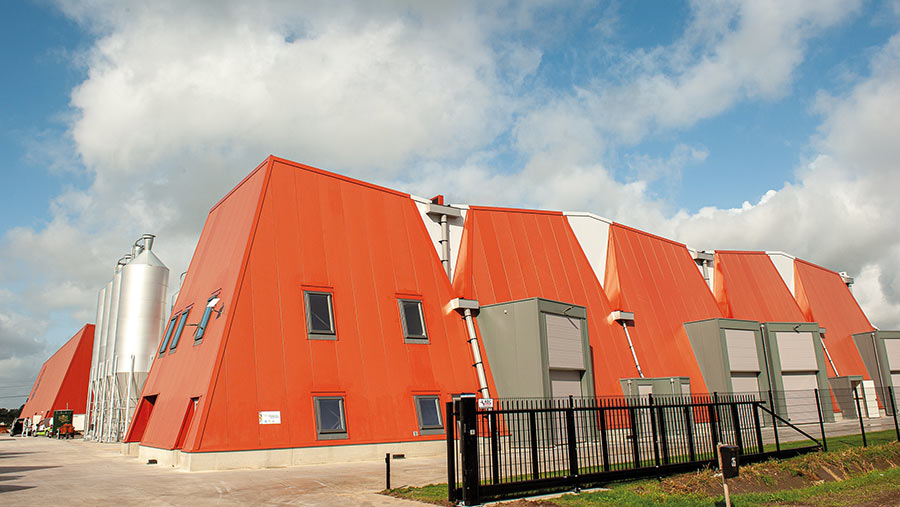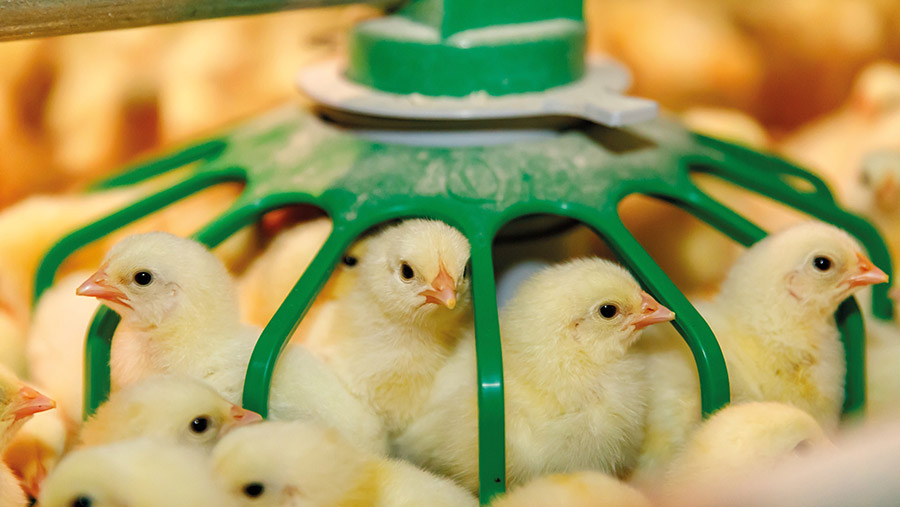What’s in Your Poultry Shed? visits a state-of-the-art closed Dutch system
 © Kuijpers Kip
© Kuijpers Kip Marcel Kuijpers, his brother and two nephews, farm a huge state-of-the-art poultry unit in the Netherlands.
The ultimate goal of the business, Kuijpers Kip, is to create a fully closed system, with chicks hatched and reared in the same shed.
To close the system completely, slaughter will eventually be carried out in an on-site facility so that all transport will be cut from the production chain.
See also: How on-farm hatching can improve flock health and cut costs
Currently, Mr Kuijpers has 256,000 broilers on site, with 85,000 parent stock producing 4m hatching eggs a year.
“I wanted to remove transport from the production chain because you send broilers off to slaughter and never hear more than their weight and price,” Mr Kuijpers says.
By covering the whole chain it is possible to get feedback from every part of production and to make necessary management changes more quickly.
Without transport, it’s a more welfare-friendly system for the birds and the planet benefits because of the reduced carbon emissions, he says.
Mr Kuijpers decided he wanted to eliminate the haulage aspect of poultry production as long ago as 2000.
At the time, his vision was unique, so designing and building the hatchery system had to be done from scratch. It then took almost 15 years to obtain all of the permits necessary for the new units.
Construction at the site close to the city of Grubbenvorst, in the Limburg region of the Netherlands, finally began in 2015.
Hatchery

© Kuijpers Kip
- 85,000 parent stock
- 4m eggs a year
The on-farm hatchery overcomes some of the variability in day-old chicks from a dedicated hatching company.
That is because chicks tend to hatch over a 72-hour window. The first ones to break out then have the longest to wait on a traditional hatchery before they arrive at a broiler unit with access to feed and water.
Chicks may also have a more stressful experience as they have to be transported from the hatchery to the farm, explains Mr Kuijpers.
At Kuijpers Kip, this stress is eliminated and candled eggs from the hatchery are transferred to the rearing area where the climate is carefully monitored over the three days that the chicks hatch.
Food and water points are accessible to all chicks as soon as they hatch, giving them a better start.
Broiler unit

© Kuijpers Kip
- 256,000 bird places
- 64,000 birds a shed
- 32,000 in two sections in each shed
Each self-contained shed comprises a six-layered vertical aviary, with chicks on wood shavings.
According to Mr Kuijpers, trials have shown that birds hatched in their growing sheds have better immunity to diseases.
Researchers found the birds had higher immunoglobulin levels in their blood, giving them improved resistance to bacteria and infections.
This is borne out by almost zero antibiotics use at the farm. However, vets are involved throughout the lifecycle of all birds. Care and vaccination plans are in place to ensure health and welfare are maintained.
Mr Kuijpers has also introduced a process of constant review across the hatchery and broiler unit to recognise, and act on, any anomalies in his production chain.
This involves collecting and analysing data through every lifecycle, including monitoring feed intakes, growth conversion rates and barn climate.
In a novel project backed by a local university and other poultry firms, Mr Kuijpers has begun listening to birds to understand what they are experiencing.
The aim of the trial is to design a tool that will work out when birds are stressed by the sounds they make and, ultimately, to develop an alarm system that provides an early warning if feed, temperature and even draughts cause bird stress.
This attention to detail has led to excellent performance figures in the broiler unit.
Performance and welfare
- 70% grow to 2.7kg at 40 days
- 30% grow to 1.8kg at 35 days
- FCR – 1.55 (10% better than average)
- Mortality 2%
- Low disease rates
- Almost zero antibiotics use
- Leg conditions improved to lower than 10% of accepted target.
Energy recovery system
While the overall concept is ahead of its time, the climate control setup is also cutting edge – exploiting a closed heat-transfer system.
There is no gas connection or other heating in the broiler sheds. Instead, heat is harvested from areas containing older birds and recycled to younger birds, which are less able to sustain their own body temperature.
“It’s about managing the supply and demand of heat that’s tied up with the birds,” says Mr Kuijpers.
Key to the system is an Innov+ air scrubber fitted to all of the sheds. Air scrubbers limit odours, dust and ammonia emissions.
But crucially, as well as removing ammonia emissions, the scrubber recycles the warm air produced in the broiler sheds and eliminates risk of disease by transferring it, germ-free, to the smallest chicks.
The system works by using the outgoing ventilation air to heat the cleaning water in the scrubbers. The water then passes through heat exchangers and is used in two ways.
Some of it is used to preheat the incoming ventilation air, allowing warm but fresh, conditioned air to enter the house even on cold days.
The remaining recovered heat is boosted to 45C via a heat pump and this is piped to areas with young chicks.
The system has a very high efficiency factor, using just 1kW electrical energy to recover 77kW of thermal energy.
Electrical power for the system and all of the farm’s energy requirement is derived from solar panels.
With a total of 1mW, the panels produce enough energy to supply 250 homes and easily meet the farm’s needs. It is an extremely efficient process and running costs have been slashed by 70%.
The innovations mean the farm achieves emission levels that are 30-40% lower than those of traditional farms supplying supermarkets.
Slaughterhouse plans
Mr Kuijpers’ eventual aim is to build an on-site slaughterhouse to bring carbon emissions and welfare standards to a new level, by removing the transport element.
The facility will be kept as small as possible initially, but in time will slaughter 4,000 birds an hour over an eight-hour working day.
It will mean the birds don’t leave the site during their lifetime and at full growth will be caught automatically and stunned, avoiding stress.
Ultimately the farm aims to increase to one million broilers, divided into 16 different age groups, on site at any one time.
But expansion plans and the on-site slaughterhouse have come to a standstill due to pressure from animal rights campaigners.
Mr Kuijpers blamed misleading information circulated about animal welfare standards, which is swaying public opinion against aviary systems in the Netherlands.
He says his system demonstrates the highest level of animal welfare, with vet care and low transport levels cutting stress from the production chain. The expansion plans would make it even better in terms of welfare and the environment, he argues.
But because he doesn’t operate a slower growing, or free-range system, animal welfare groups are against it.
Public lobbying of supermarkets has resulted in them pledging to sell eggs from perceived higher welfare systems, leaving Mr Kuijpers unable to sell his product in the Netherlands. Instead, he is currently having to export to the UK.
He believes discussions should be based on balancing welfare and carbon emissions to safeguard production of affordable, healthy, environmentally friendly food to supply a growing world population.
